Apple iPad mini with Retina Display: Reviewed
by Anand Lal Shimpi on November 16, 2013 8:00 AM ESTThe SoC
The iPad mini with Retina Display rounds out the three platforms that use Apple’s A7 SoC. Although both the iPad Air and iPhone 5S use the A7, the mini’s implementation is closer in nature to the iPhone. The iPad mini’s SoC has always used the same package-on-package (PoP) assembly as the iPhone, with DRAM stacked on top of the SoC itself (1GB in this case). The benefit is obviously a reduction in board area, the downsides have to do with cost and thermals. That’s the first similarity between the mini’s A7 and the iPhone’s A7.
The second is one of frequencies. While the iPad Air’s A7 runs its two Cyclone CPU cores at up to 1.4GHz, the SoC in the iPad mini and the iPhone 5S runs at up to 1.3GHz. That might sound like a minor difference, but it’s far more pronounced when you look at what happens to frequency when you’re running heavy workloads.
Once again I turn to a fairly heavy CPU workload to plot performance over time. This is a multithreaded workload, slightly modified from what we used in the iPad Air review, designed to make the CPU cores consume max power. The scale is linear and the workload is the same across all devices, so what you’re effectively looking at is a graph of thermally bound CPU performance over time across all three A7 implementations:
Being the largest device (and the only device with a metal heat spreader and no DRAM stacked on top), the iPad Air obviously maintains the highest frequencies for the duration of the test. The iPhone 5S, with a significant reduction in internal volume (and a PoP SoC) reduces its CPU frequencies early on in order to keep skin temperature down and properly manage thermals. The iPad mini with Retina Display falls between the two, with its performance curve more closely following that of the iPhone 5S.
Although the mini has a similar max operating frequency to the iPhone 5S, it is a faster device thanks to it being less thermally constrained. Similarly, the iPad Air can be much faster than its clock speed would otherwise imply. If you’re wondering why Apple has been so focused on building its own SoCs and CPU architectures, this is the reason why. There’s a fixed amount of power you can dissipate in the form of heat in these mobile devices while still maintaining a good user experience. Performance per watt is the gating metric for success in mobile, and shipping high IPC/low frequency dual-core SoCs at 32/28nm is the best optimization available to a company like Apple today.
As you’d expect, our browser based CPU tests show the mini’s A7 performing in between the iPhone 5S and iPad Air. None of these tests are anywhere near as stressful as our thermal test from above, so we don’t see exaggerated differences in performance between the platforms. For most, I suspect you won’t notice a huge performance difference between the mini and Air. Those who are heavier users (e.g. audio mixing, 3D gaming, etc…), there will be a performance difference between the two iPads.
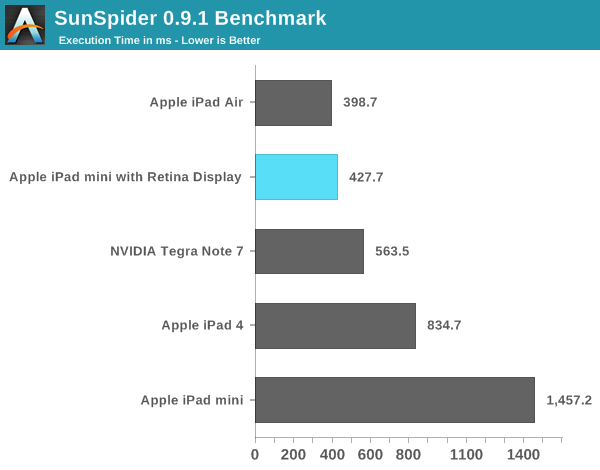

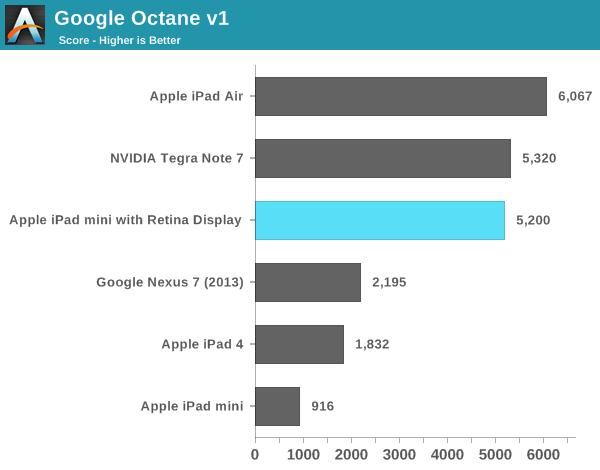
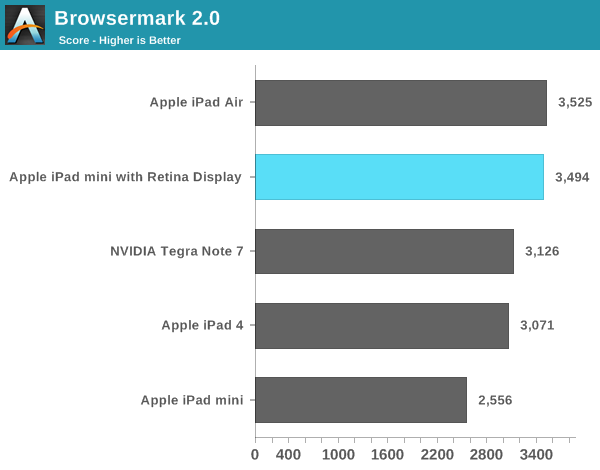
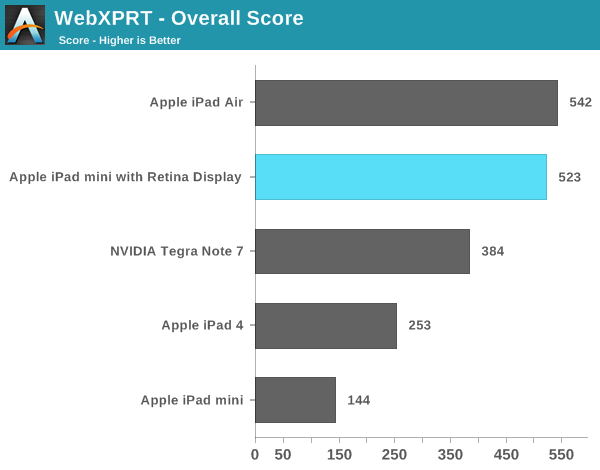
Compared to the first generation iPad mini, the new model is in a completely different performance league. Keep in mind the first mini used Apple’s A5 SoC based on an ARM Cortex A9. That’s the same single threaded performance as what’s in an iPhone 4S, and under iOS 7 it’s clearly running into some performance limits. The new mini with Retina Display however is a completely different animal. It’s fast.
Even comparing to the 4th generation iPad, the new mini is noticeably quicker.
Memory Bandwidth
Looking at the iPad mini’s memory bandwidth curve, we see it tracks very closely with that of the iPhone 5S. This is a slightly modified version of our previous bandwidth test, and you can see peak usable memory bandwidth (from the CPU’s perspective) of around 10GB/s. The ~12GB/s area right before you get out to main memory is bandwidth to the A7’s 4MB system-wide cache that sits after the shared L2 and the memory controller. This cache appears to service CPU, GPU and ISP requests at least.
GPU Performance
I believe the A7’s PowerVR G6430 GPU runs at around 450MHz. This frequency appears unchanged across all three A7 implementations. Once again, the big difference is how much thermal headroom exists in the platform which has an impact on overall performance.
Kishonti’s low level GPU performance tests back up my assertion that GPU frequency is fixed across all A7s. The iPad mini with Retina Display delivers equal performance to the iPad Air. The bigger news here is that nearly all of the GPU bound 3D tests seems to peg the mini and Air as equals. These are some pretty intense tests, but it looks like on the GPU side there’s no significant throttling when running at full tilt.
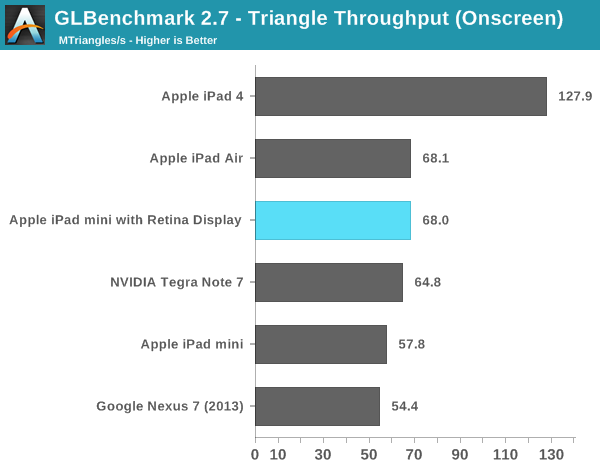

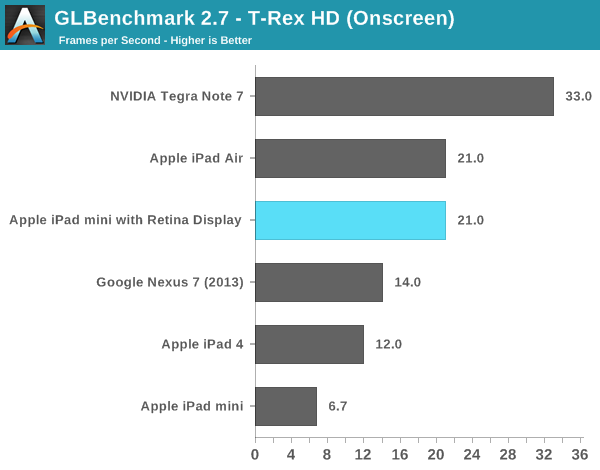

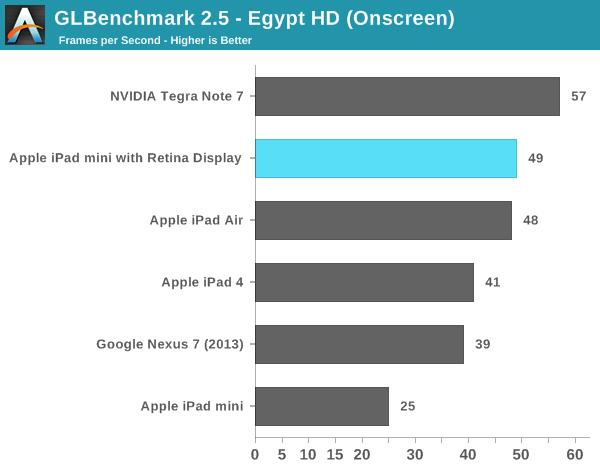
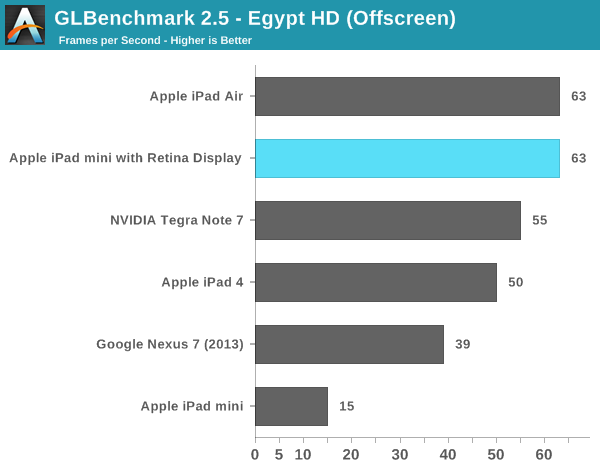
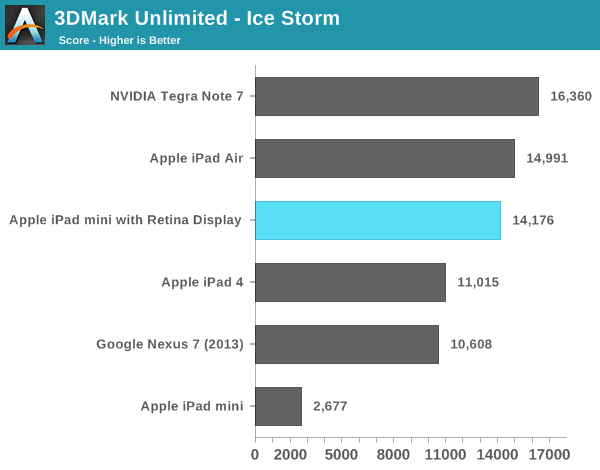
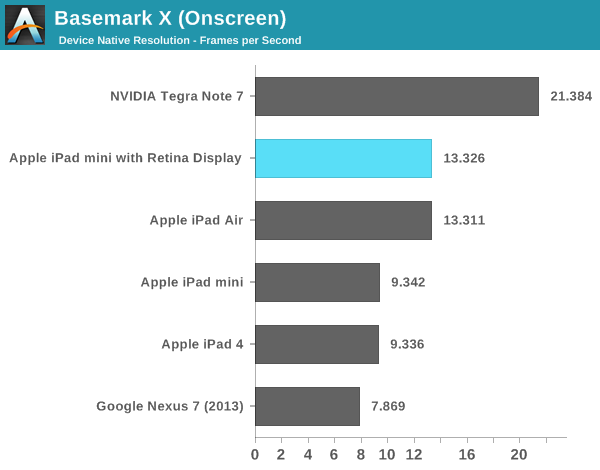
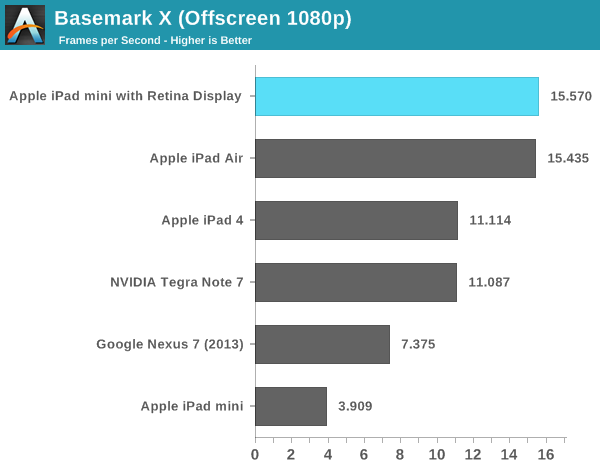
As I mentioned in our iPad Air review, despite having less peak theoretical memory bandwidth than the A5X/A6X, the A7 in the iPad mini never seems to regress in performance compared to even the iPad 4. Across the board the mini appears to be faster, more responsive and have more performance on tap than any prior iPad (big or small). The comparison to the original iPad mini is of course night and day. Even looking at lighter tests like the old GLBench Egypt HD benchmark, the iPad mini with Retina Display manages to be nearly twice as fast as the original mini - all while rendering 4x the number of pixels.


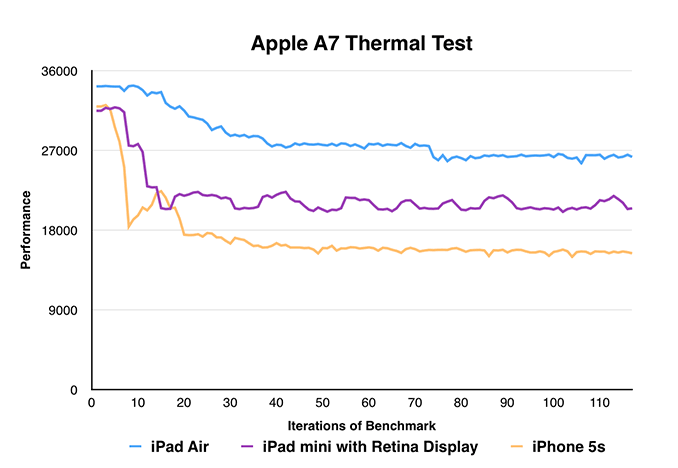
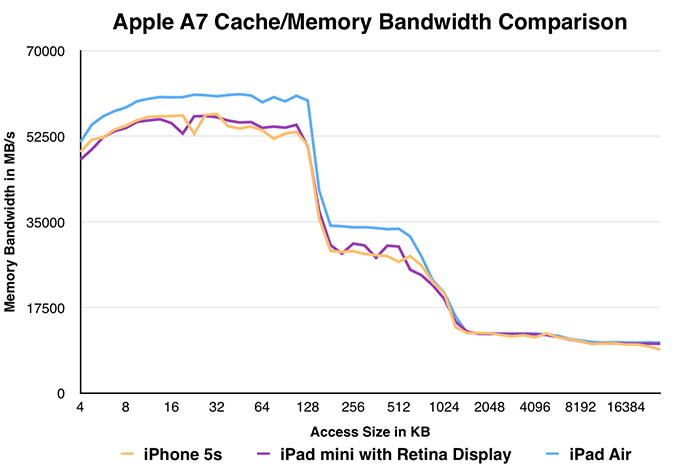








345 Comments
View All Comments
michal1980 - Saturday, November 16, 2013 - link
you must not have been here long enough. I'm still waiting for anand to change his name to appletigmd99 - Saturday, November 16, 2013 - link
Prove his bias.tigmd99 - Saturday, November 16, 2013 - link
What has he said about either OS that is not true?Puberticus - Saturday, November 16, 2013 - link
Seriously: if you don't like Apple gear and you weren't interested in a detailed review, why are you even commenting?pgari - Saturday, November 16, 2013 - link
I found Anand reviews a lot more unbiased (if any) than most of the people criticizing him: as a minimum he recognizes the weakness on Apple products as well the competitors' strengths, no as some people here who demonize Apple and reject all its products blindly.Disclaimer: My smartphone is a Nexus 5, my tablet a Venue 8 Pro and my laptop a MBA
tipoo - Saturday, November 16, 2013 - link
Shame about the inferior display gamut and slower soc. Makes the choice between it and Air a bit muddier. Funny how when the first display comparisons went around the apple faithful thought it was a hoax, lol.solipsism - Saturday, November 16, 2013 - link
For me it's not a deal breaker as I never use my iPad much. It's mostly for reading so I'm hoping the iPad Mini will be a better fit than the 10" variant.Overall that display is very impressive, but those displays on Amazon Kindle HGX and Nexus 7 are even more impressive when you consider their cost. Sure, they aren't profiting and use them to sell there other services unlike Apple who's model is to sell HW, but's still impressive. The only reason I haven't chosen them since I can read just fine on them is the awful 16:10 and 16:9, respectively, aspect ratio. 4:3 is considerably more ideal and I wish others would follow.
teiglin - Saturday, November 16, 2013 - link
Both of the Kindle Fire HDXs and the Nexus 7 are 16:10 (1920x1200 on the 7"-ers, and 2560x1600 on the HDX 8.9). Also the phrase "considerably more ideal" makes my brain hurt. As Brian once said, the battle for 4:3 is over and lost outside the iPad space (and LG phablets -_-)--even the iPhone gave up that ghost. I do miss 4:3 on the desktop though.solipsism - Saturday, November 16, 2013 - link
1) The iPhone was never 4:3.2) "More ideal" is not the same as "ideal".
3) There is obsolescing of aspect ratios as much you want to believe there is such a thing. There is only aspect ratios that are utilized for specific purposes and on a tablet 16:9 or 16:10 is not good for reading text, but 4:3 is. 16:9 is *more ideal* than 4:3 for video since it's closer to the common widescreen formats but most users don't spend the majority of their time watching videos.
teiglin - Sunday, November 17, 2013 - link
1) You're right, old iPhones were 3:2, but the point is that it gave up the fight against widescreen, just like other market segments.2) And I still take semantic issue with the idea of comparative ideal-ness--something is ideal, or it isn't. Something can be better or worse for a particular purpose, or closer to the ideal, but not more or less ideal.
3) Either you're missing a "no" in your first sentence, or I'm very confused. Either way, aside from my semantic quibbles, I don't generally disagree with what you're saying--4:3 is generally better for interacting with text than 16:9/10. Nevertheless, the fact remains that 16:9 is the standard for the vast majority of displays sold today, no matter how much I miss my first desktop LCD with its 5:4 aspect ratio.
What I find interesting in the discussion of aspect ratio is the lack of actual measurements. I mean, people mostly compare 7" tablets to the iPad mini, but the iPad mini's display is actually the same width as the 8.9" Kindle Fire's display (give or take a few hundredths of an inch). So maybe that should be the point of comparison for how much text you can display?